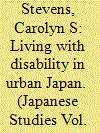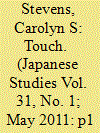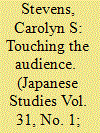|
|
|
Sort Order |
|
|
|
Items / Page
|
|
|
|
|
|
|
| Srl | Item |
| 1 |
ID:
080028


|
|
|
|
|
| Publication |
2007.
|
| Summary/Abstract |
This article explores the uneasy juxtaposition between the user access and user reality of 'barrier-free design' (bariafurii desain) in urban Japan. It argues that the growing number of accessibility features in Japanese public spaces has not necessarily resulted in a 'barrier-free' society. While these visible reminders raise public awareness about the difficulties physical and intellectual disabilities present to individuals, people with disabilities and their carers still live in physically narrowed spaces, primarily because of the reality of the urban landscape and pressure from the number of users
|
|
|
|
|
|
|
|
|
|
|
|
|
|
|
|
| 2 |
ID:
104163


|
|
|
| 3 |
ID:
104166


|
|
|
|
|
| Publication |
2011.
|
| Summary/Abstract |
Japanese popular music as embedded in television commercials is taken as a point of departure for understanding consumer aesthetics and practices, and how music and image can touch - or, create a lasting impression on - an audience. This phenomenon, called the tai-appu (tie-up), or an alignment between artists and products, results in an ime-ji songu (image song). These contracts between manufacturers and artist have been ubiquitous in the Japanese media landscape since the early 1980s. While tie-ups can be considered a kind of celebrity endorsement, common in many consumer cultures, they play a more prominent role in Japanese popular culture, edging out MTV-style videos as the primary method that artists use to promote their music. The success of these mini-videos can be attributed to the tie-ups' multisensory impact (with multiple images, text and sound in movement) and their overall audience accessibility. Understanding these compressed media messages is important due to recent concern about the way advertising invades, rather than enriches, the media landscape. Advertising analyses contribute to our understanding of how a society's economy and culture are inter-related; tie-ups give us particular insight into the connections between culture (music and image), economy (product popularity and sales figures) and society (audience formation and reception), and highlight the importance of sensory experience in popular culture.
|
|
|
|
|
|
|
|
|
|
|
|
|
|
|
|
| 4 |
ID:
098371


|
|
|
|
|
| Publication |
2010.
|
| Summary/Abstract |
In recent years, Japanese popular culture has received much attention both inside and outside the academy. Its success overseas has contributed to theories of transnational cultural flow, 'soft power' and 'Gross National Cool'. At the same time, public opinion of fans, both in Japan and overseas, remains low. This article attempts to rescue fandom from its current association with social ostracism, placing it instead in a logical structure of a historical consumer culture in Japan and in the West. Fandom can be considered a rational consumer strategy, rather than a deviant psychological attribute, when considered within the hyper-developed context of a media-saturated, late-capitalist consumer society. Fandom, when viewed from this perspective, can be distinguished from pathological behaviour and focuses on pleasure, the pursuit of social capital, and individualised identity building, especially in a society where traditional corporate groups such as the family or the workplace no longer offer the same attraction.
|
|
|
|
|
|
|
|
|
|
|
|
|
|
|
|
|
|
|
|
|